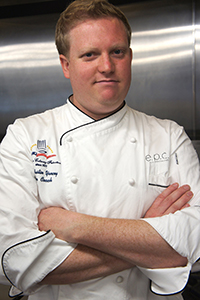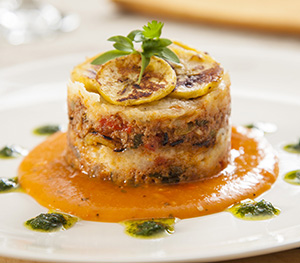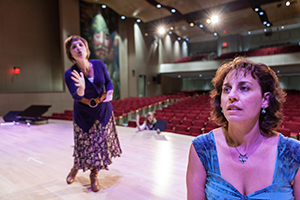50-Minute Classroom: How to Order
 For newer culinary-arts teachers, ordering can seem a daunting task. But it’s really quite simple, says Chef Weiner, who suggests three basic ways to order for day-to-day teaching (while taking into consideration two common snags). His chief advice? Under order.
For newer culinary-arts teachers, ordering can seem a daunting task. But it’s really quite simple, says Chef Weiner, who suggests three basic ways to order for day-to-day teaching (while taking into consideration two common snags). His chief advice? Under order.
By Adam Weiner, CFSE
This article is dedicated to the newer instructors. If you are experienced in ordering for teaching purposes, then feel free to skip this article and join me again next month.
If you are new to teaching, you have only been ordering for your class for a short time. By now you are probably banging your head into the wall, particularly if you have never ordered for a foodservice facility.
In the beginning, new chefs and instructors tend to over order. This is only slightly burdensome for non-perishables and freezer items (although sooner or later space becomes an issue). This can be a real money loser for perishable items that can’t be frozen.
WORK VERY HARD to under order. Remember, your job is to teach the students how to cook—not to feed them. If they only get a half serving (or even a taste), so be it.

 As much as our primary educational mission is to prepare students to be professionally successful in their chosen career, Chef Sorgule asserts our obligation extends far beyond: Educators have a responsibility to help mold good citizens, community leaders and honorable members of society.
As much as our primary educational mission is to prepare students to be professionally successful in their chosen career, Chef Sorgule asserts our obligation extends far beyond: Educators have a responsibility to help mold good citizens, community leaders and honorable members of society. From recipes to roe, and from properly extracting meat from the shell and paring it with wines, this free online learning course from The Culinary Institute of America is suitable for culinary-arts students in class and as homework.
From recipes to roe, and from properly extracting meat from the shell and paring it with wines, this free online learning course from The Culinary Institute of America is suitable for culinary-arts students in class and as homework. A successful, time-honored business in Northern California projects saving 65% of current energy usage thanks to a new solar-energy system it recently installed, helping to shape the future of the baking industry.
A successful, time-honored business in Northern California projects saving 65% of current energy usage thanks to a new solar-energy system it recently installed, helping to shape the future of the baking industry. The BCA Global’s 21st-Annual Cultural Awareness Salute and Black Tie Gala will be held Nov. 21, 2014, at the Crowne Plaza Times Square Manhattan in New York City to honor the achievements of people of color in the industry.
The BCA Global’s 21st-Annual Cultural Awareness Salute and Black Tie Gala will be held Nov. 21, 2014, at the Crowne Plaza Times Square Manhattan in New York City to honor the achievements of people of color in the industry. The
The  Entries in the 2014 Discover Duck Recipe Contest proved that the possibilities with duck are boundless. Concepts ranging from Latin-influenced entrées to decadent desserts and upscale state-fair favorites captured the attention of judges who awarded more than $19,000 in cash and prizes. Sponsored by Maple Leaf Farms, the annual contest challenged professional chefs and culinary students to produce original recipes showcasing Maple Leaf Farms duck. More than 260 recipes from across the country were submitted.
Entries in the 2014 Discover Duck Recipe Contest proved that the possibilities with duck are boundless. Concepts ranging from Latin-influenced entrées to decadent desserts and upscale state-fair favorites captured the attention of judges who awarded more than $19,000 in cash and prizes. Sponsored by Maple Leaf Farms, the annual contest challenged professional chefs and culinary students to produce original recipes showcasing Maple Leaf Farms duck. More than 260 recipes from across the country were submitted. The Culinary Institute of America and Half Moon Theatre, the Hudson Valley’s leading year-round professional theatre company, recently announced a new partnership that will bring New York-style theatrical performances to the Hyde Park campus. The CIA’s new 800-seat, state-of-the-art Ecolab Auditorium in the Marriott Pavilion makes it possible for visitors to enjoy a meal in either the The Bocuse Restaurant, American Bounty or Ristorante Caterina de’ Medici prior to experiencing one of Half Moon Theatre’s productions.
The Culinary Institute of America and Half Moon Theatre, the Hudson Valley’s leading year-round professional theatre company, recently announced a new partnership that will bring New York-style theatrical performances to the Hyde Park campus. The CIA’s new 800-seat, state-of-the-art Ecolab Auditorium in the Marriott Pavilion makes it possible for visitors to enjoy a meal in either the The Bocuse Restaurant, American Bounty or Ristorante Caterina de’ Medici prior to experiencing one of Half Moon Theatre’s productions. On its 80th anniversary, Kendall College’s president envisions a future in which everyone worldwide with a passion for food may pursue their dreams to cook professionally.
On its 80th anniversary, Kendall College’s president envisions a future in which everyone worldwide with a passion for food may pursue their dreams to cook professionally.